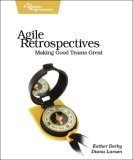In yesterday’s post, I told how Rachel Davies encouraged us to reflect and improve using “Retrospectives”.
 Great advice, but how do you convince people to hold a retrospective? How do you organize a Retrospective? How do you get useful information? What do you do with what you learned during the retrospective?
Great advice, but how do you convince people to hold a retrospective? How do you organize a Retrospective? How do you get useful information? What do you do with what you learned during the retrospective?
The classic book about retrospectives was written by Norm Kerth. It answers all of these questions, and then some more. There is a particular emphasis in the book on creating a “safe environment”, where everybody can contribute without fear. Especially when the project hasn’t gone too well (and you could well learn a lot of useful information), you need to do a lot of work to get rid of the “poisonous” atmosphere that may have built up in the team. I spoke with Norm at SPA2006 and attended his keynote. If I have a team that’s really in trouble, I’d want Norm to come in, because he has the experience and techniques and knows how to deal with difficult situations. And he can tell great stories.
 Ester Derby and Diana Larsen have published their “Agile Retrospectives” with the Pragmatic Programmers. As usual with the Pragmatic Duo’s books, it’s a thin (+/- 160 pages) book with large readable fonts and many illustrations. There’s less information (the first 40 pages or so) about how to lead retrospectives than in Norm’s book. This is more a book for people who know what retrospectives are and can get more information from other sources, like the “Retrospective Facilitator’s Gathering“.
Ester Derby and Diana Larsen have published their “Agile Retrospectives” with the Pragmatic Programmers. As usual with the Pragmatic Duo’s books, it’s a thin (+/- 160 pages) book with large readable fonts and many illustrations. There’s less information (the first 40 pages or so) about how to lead retrospectives than in Norm’s book. This is more a book for people who know what retrospectives are and can get more information from other sources, like the “Retrospective Facilitator’s Gathering“.
As the book says at the end of chapter 3 “Leading Retrospectives”: “You are probably an expert at what you do now. Facilitation draws on different skills than most of us develop working in software. Facilitation also requires a different perspective. It takes time and practice to feel comfortable with new skills.” Effectively facilitating a retrospective (or any other event) takes a lot of skill. Having such a short introduction to the skill of facilitating retrospectives, this book is more aimed at people who already know what retrospectives are and have performed some. There’s not enough information for newbies, who are better served with Norm’s book.
Where the book shines, is in the second part. Here, we find a large list of activities we can perform during a retrospective. Each activity starts with a “Purpose” section, so you can select the right activities for the goal you want to reach. The activities are organized in several sections, for each phase in the retrospective:
- Setting the stage
- Gathering data
- Generate insights
- Decide what to do
- Close the retrospective
I found some interesting activities that I can apply and some ideas for new activities. The handy reference format is a useful tool when planning a retrospective. When you run regular retrospectives, participants can get bored with performing the same activities over and over. Having such a wide selection of activities to choose from, makes it easier to keep retrospectives “fresh” or selecting the appropriate activity for the group and situation.
This book is recommended for people with some experience with retrospectives. As with most things where humans are involved, a word of caution is in place: be careful, you’re dealing with people’s emotions and feelings. A retrospective after a succesful project is relatively easy. A retrospective for a challenged or failed project is hard and dangerous. Get a pro or some training before you embark on such a venture.
Retrospectives are absolutely essential to become and stay agile. But be careful out there. “Coach” or “facilitator” is not a term that should be taken lightly. It takes skill and experience.